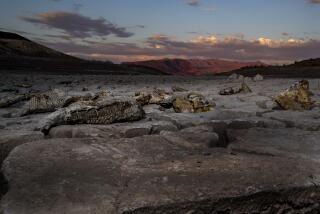The Great Drought : Fickle Weather in 1860s Led to Breakdown of Cattle Industry
- Share via
The climate was bone dry.... There was no moisture and our cattle died off in very great numbers ... Before the year 1864 had passed away, there was perfect devastation. Such a thing was never before known in California. --Juan Forster, Rancho Santa Margarita Droughts are common in California, always have been. Long before scientists suggested a “greenhouse effect” and the possibility of permanent climatic change, pioneers coped with erratic and disastrous wet/dry cycles.
The drought of 1862-65 was a catastrophe for the state of California--a bitter dry period, preceded by unusually heavy rains and accompanied by an untimely epidemic of smallpox.
The decade of the 1860s began with little hint of the natural catastrophes ahead. For several years in succession, gentle autumn and winter rains had fallen with consistency, supporting vast grasslands that fed immense herds of cattle.
But in the winter of 1861-62, rains of biblical proportions came to California.
The rain fell for almost a month, inundating river valleys, farmlands and towns. The persistence of the rain led the editor of the Los Angeles Star to comment: “On Tuesday last the sun made its appearance. The phenomenon lasted several minutes and was witnessed by a great number of persons.”
In San Diego, the flooding washed away soil and timberlands, destroyed vineyards, melted adobe houses, and drowned livestock. At San Luis Rey, the raging floods “cut an arroyo 50 feet across.” An estimated 200,000 head of cattle were lost in California.
But in the spring, the rain-soaked grazing lands flourished. Herds of cattle recovered quickly in the abundant pasturage.
Then came three years of intense drought. In the fall and winter of 1862-63, only 3.87 inches of rain fell in San Diego County. As the grasslands dried up, the long-horned cattle grew emaciated and weak. The overstocked ranchers tried to minimize their losses by thinning their herds. The markets became flooded with cowhides and prices fell.
From Santa Margarita (modern-day Camp Pendleton), rancher Juan Forster would write in January, 1863: “We poor Rancheros have had a damned bad string of luck these last two years and if it is going to continue I don’t know what will become of us.” To cut losses, Forster drove his herds into the mountains, saving perhaps half his cattle.
At Rancho Guajome near San Luis Rey, rancher Cave Couts complained in early spring that there was no grass, that it was as dry as August, and that smallpox was beginning to take a toll.
The outbreak of smallpox in California added human misery to the growing economic toll. Appearing in the fall of 1862, the plague quickly spread throughout Southern California. Effective quarantines proved impossible and vaccine could only be obtained from San Francisco.
Cave Couts reported: “Smallpox is quite prevalent--six to eight per day are being buried in S. Juan Capistrano--Indians generally. . . . I vaccinated the whole rancheria at San Luis some six weeks since, & hope they may escape, thus saving our community of the terrible disease.”
By late spring, the smallpox epidemic had run its course, but the drought continued. A little more than five inches of rain fell in 1863-64. More and more ranchers drove their cattle into the mountains in the search for grass and water. Other cattlemen moved their herds to Baja California. From San Luis Rey, Couts would moan: “I am badly in want of money . . . taxes on hand, no goods in my shop & no money.”
As the drought lingered, the bad luck of ranchers continued. A violent storm that broke in May killed famished cattle grazing in the mountains. Forster lost 300 head in one night at San Ysabel. When summer came, strong dry winds were reported and grasshoppers appeared, which soon stripped the remaining forage.
The drought finally began to ease in November, 1864. Two and half inches of rain fell, followed by more than five inches in the next two months. Not until the 12-inch season of 1864-65 did the cattlemen feel secure.
The Great Drought virtually ruined the once-great cattle industry of California. Statewide, herds declined by about 46% in the 1860s. The numbers are unknown for San Diego County but in Los Angeles County the loss was more than 70%.
The long-term impact did show a few benefits. Ranchers learned to plant feed crops in order to lessen their reliance on natural forage. The raising of sheep (a far more “drought-tolerant” animal than a cow) became popular. In North San Diego County, a more diversified agricultural economy slowly developed.
More to Read
Sign up for Essential California
The most important California stories and recommendations in your inbox every morning.
You may occasionally receive promotional content from the Los Angeles Times.













